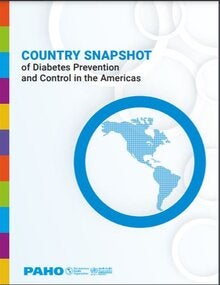[Pronto disponible en español]
Overview
Diabetes is a major public health problem in the Americas and worldwide, demanding special attention and integrated response. It is estimated that more than 62 million adults are living with diabetes in the Americas. The projections show that diabetes prevalence will continue to increase to at least 2025. Its steady rise has been mainly due to the high prevalence of risk factors, especially overweight/obesity and physical inactivity. Diabetes also is one of the leading causes of mortality and disability worldwide and across our Region. Moreover, its disability complications generate poor quality of life for people living with diabetes. This scorecard provides rapid visualization of the status of diabetes, its risk factors, and the response capacity of the countries. Showing the age-standardized prevalence of raised fasting blood glucose/diabetes, overweight/obesity, physical inactivity, and raised blood pressure in adults. It also includes crude estimates prevalence of overweight/obesity in adolescents. The data is shown by sex, country, and the regional mean. It also presents the diabetes deaths for countries in the Americas region, including information on the age-standardized per 100,000 population death rates and population disability-adjusted life year (DALY) due to diabetes. The data are from the World Health Organization (WHO) estimates (Global Health Estimates (2010,2016) to ensure the comparison between countries and with previous country data. This tool also includes a summary of the country’s health system response to diabetes, including national plans, targets, surveillance, guidelines, and access to essential drugs and technologies from the WHO Capacity Country Survey 2019. This tool highlighted the ten countries with the highest values for the prevalence of raised fasting blood glucose/ diabetes, overweight/obesity, physical inactivity, raised blood pressure, and age-standardized mortality and DALYs rates from diabetes. It also shows the relative change in the prevalence of diabetes and risk factors between 2010 and the latest year available for comparable estimates. Its purpose is to build awareness of the need to prevent and control diabetes and strengthen strategies and interventions by countries that address the challenge that diabetes implies.
|

